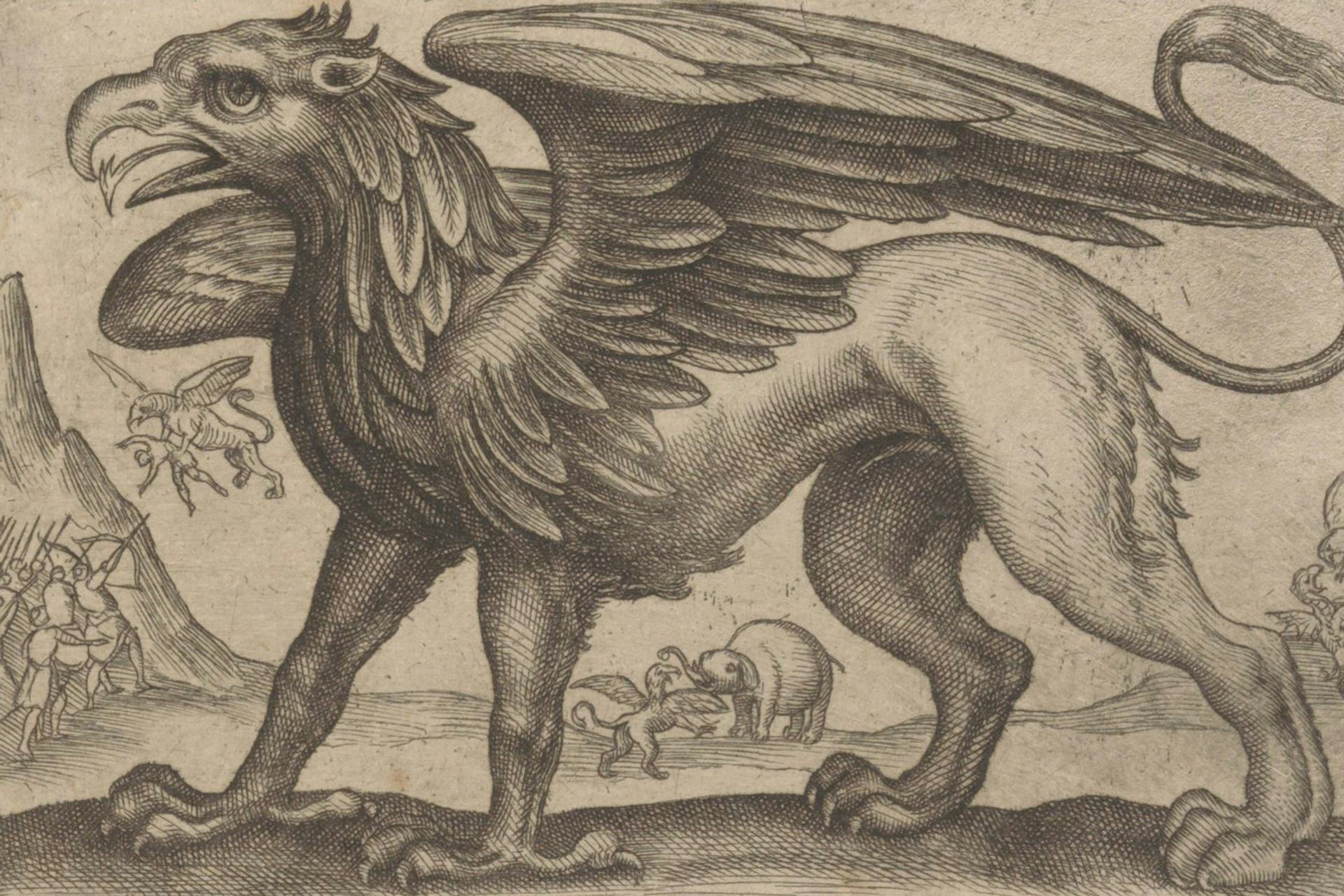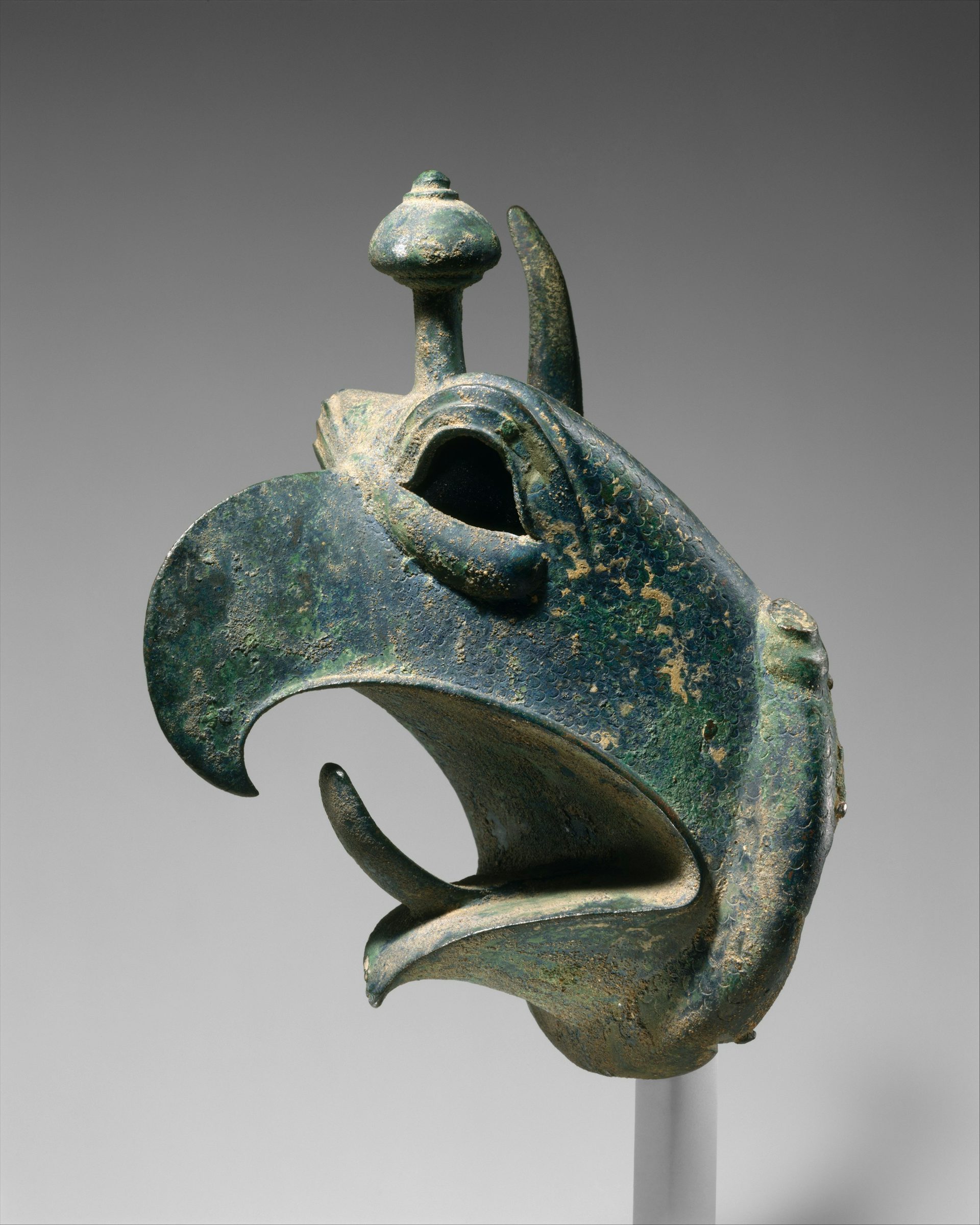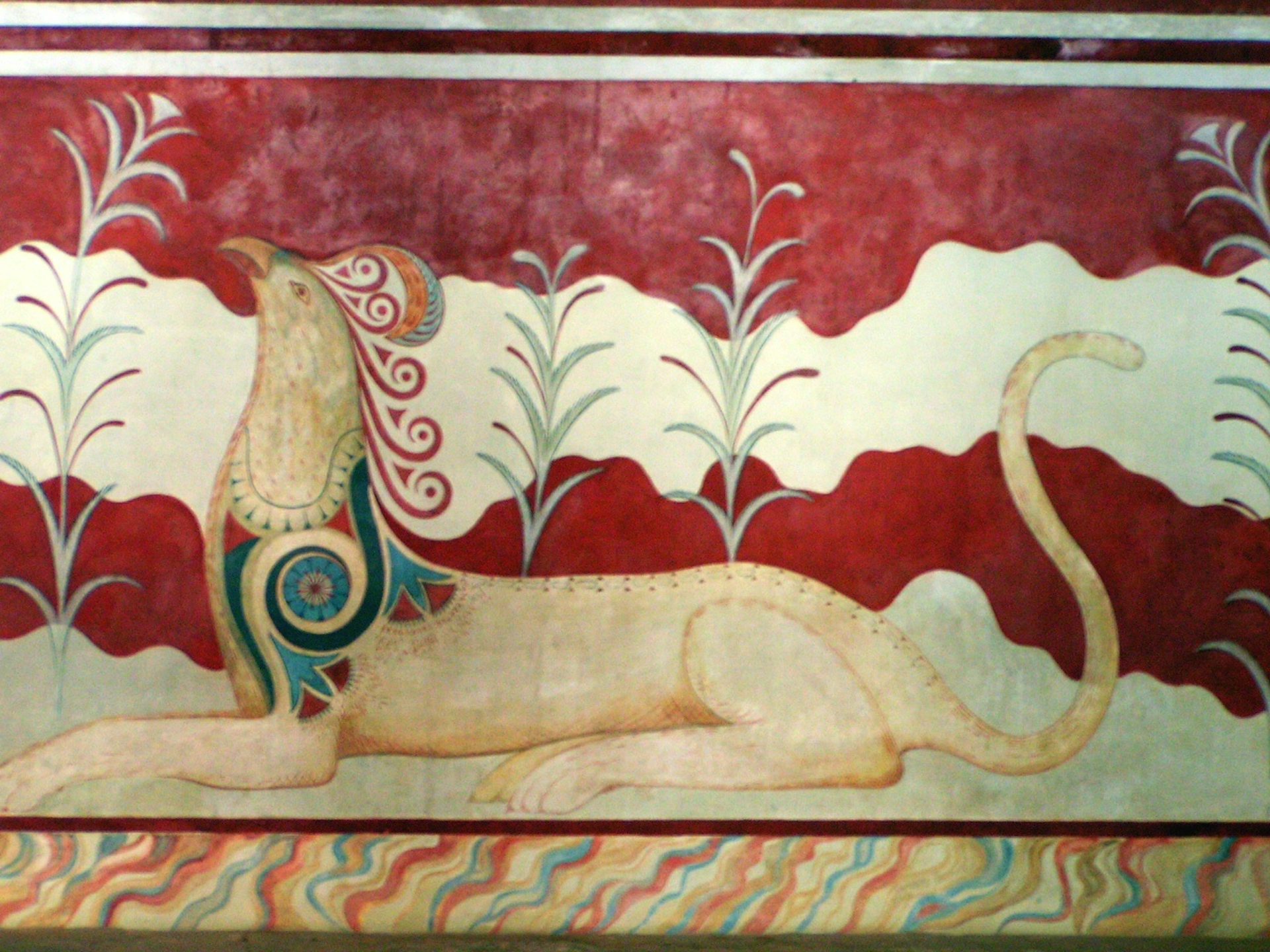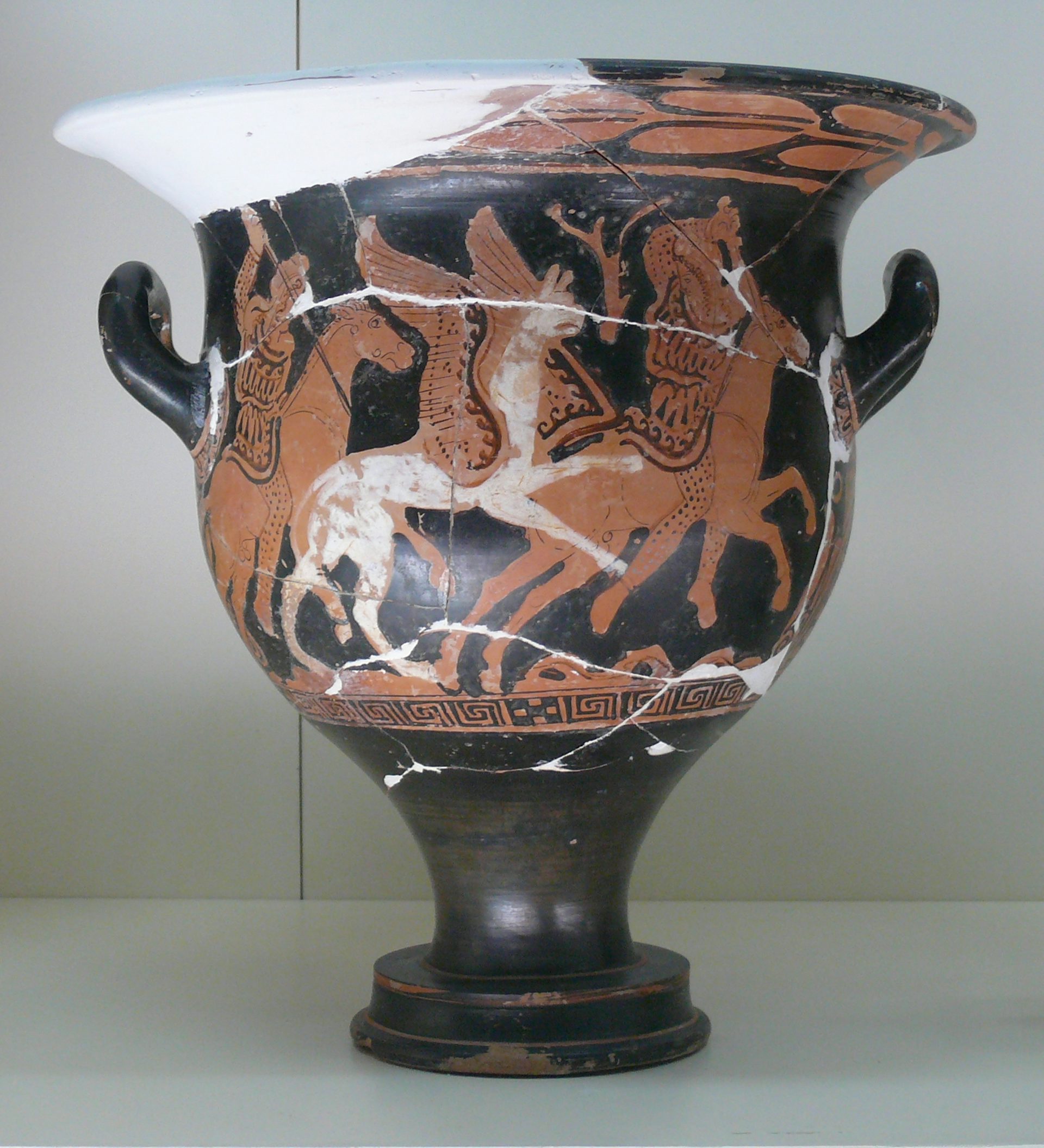Griffin

Griffioen by Antonio Tempesta (ca. 1650).
RijksmuseumPublic DomainOverview
Griffins were mythical creatures with the head and wings of an eagle and the body of a lion. They probably originated in Near Eastern art and mythology, though they arrived in Greece at a very early period. According to the Greeks, the Griffins lived at the very edge of the world, where they hoarded gold and battled the legendary race of the one-eyed Arimaspians.
Etymology
The etymology of the term “Griffin” (Greek γρύψ, translit. grýps; pl. “Griffins,” Greek γρῦπες, translit. grŷpes), sometimes also spelled “Gyphon” or “Griffon,” has been largely obscured by time. There is a possible connection with the Greek adjective γρυπός (grypós), meaning “hooked” or “bent.”[1]
Given that the creature originated in the Near East, the term may have a Semitic origin. Scholars have linked the Greek “Griffin” to the Akkadian karūbu, meaning “blessing” (not, as some have thought, “griffin” or “cherub”),[2] and the Hebrew krvḇ (“cherub”).[3]
Pronunciation
English
Greek
Griffin, Griffins Γρύψ (translit. grýps), γρῦπες (translit. grŷpes) Phonetic
IPA
[GRIF-in], [GRIF-inz] /ˈgrɪf ɪn/, /ˈgrɪf ɪnz/
Attributes
Locales
According to most Greek sources, the Griffins lived at the remote northern or northwestern edge of the world, in the steppes of eastern Europe and central Asia.[4] This region was thought to be populated by a number of strange and legendary races, including the Hyperboreans, the Issedones, and the Arimaspians. Pomponius Mela, a geographer of the first century CE, placed the Griffins in the legendary Riphean Mountains of northern Eurasia.[5]
Other sources, however, spoke of Griffins who lived in India. Like the more familiar Griffins of central Asia, these Indian Griffins also lived near gold deposits in the mountains.[6]
Appearance and Abilities
Griffins were described by the Greeks as large hybrid creatures, having the head and wings of an eagle and the body of a lion. Aeschylus called them “the sharp-beaked hounds of Zeus that do not bark.”[7] Pausanias reported a tradition in which they were also spotted like leopards, though he did not personally believe this to be true.[8]
The Griffins of India were sometimes described in more detail. These Griffins were said to be about the size of a wolf, with the legs and claws of a lion and colorful plumage: black feathers across most of their body, red breast feathers, blue neck feathers, and white wings.[9]
A noteworthy description of the Indian Griffin can be found in Philostratus’ Life of Apollonius of Tyana, where it is reported that the creatures
are held in veneration as being sacred to Helios the Sun; and the Indian artists, when they represent Helios, yoke four of them abreast to draw the images; and in size and strength they resemble lions but having this advantage over them that they have wings, they will attack them, and they get the better of elephants and of dragons. But they have no great power of flying, not more than have birds of short flight; for they are not winged as is proper with birds, but the palms of their feet are webbed with red membranes, such that they are able to revolve them, and make a flight and fight in the air; and the tiger alone is beyond their powers of attack, because in swiftness it rivals the winds.[10]
Iconography
Griffins appeared in Greek and Aegean art long before they were described in literature—as early as the Bronze Age. They remained popular throughout the Archaic (ca. 800–490 BCE) and Classical (ca. 490–323 BCE) periods.
Typical features of the Greek Griffin included pointed ears and a gaping beak. They were also often depicted with a crest or knob on top of their heads. Griffins were a popular decorative motif on bronze and pottery utensils as well as armor, where they were sometimes shown in battle or in hunting scenes.[11]

Bronze griffin head from rim of cauldron (third quarter of the 7th century BCE). From Olympia.
Metropolitan Museum of ArtPublic DomainMythology
Origins
The half-bird, half-lion Griffin came from somewhere in the Near East. Archaeological evidence points to an origin in Elam—a civilization that thrived in ancient Iran—as early as the fourth millennium BCE.
From Elam the creature spread across the Mediterranean, arriving in predynastic Egypt by around 3000 BCE. The Griffin reached Syria in the second millennium BCE, and Anatolia and the Aegean not long after that. In Minoan Crete, for example, beautiful Griffins can be seen in the painted frescoes of the Palace of Knossos (ca. 1500 BCE).[12]

Fresco (restored) from the palace of Knossos on Crete depicting a seated griffin.
PaginazeroCC BY-SA 3.0In short, Griffins found their way into the Greek cultural imagination at a very early date. They also appeared in early Greek literature: it was said that the first poet to write about the Griffin was Hesiod (possibly as early as the eighth or seventh century BCE), though we do not know the content of those writings.[13]
The Griffins’ Gold
The Greeks usually spoke of the Griffins as fierce creatures who lived at the edge of the world and watched over large deposits of gold. Ancient authors told of how the Griffins’ neighbors, a warlike, one-eyed race known as the Arimaspians, often set out on horseback to steal this gold.
In antiquity, the main source for the myth of the Griffins and the Arimaspians would have been the semi-legendary poet Aristeas of Proconnesus. This Aristeas claimed to have traveled to the Far East, where he visited the Griffins, the Arimaspians, and their other fabulous neighbors himself. Though his once-famous poem, the Arimaspea, no longer survives, several ancient authorities summarized its contents:
These griffins … fight for the gold with the Arimaspi [i.e., Arimaspians] beyond the Issedones. The gold which the griffins guard, he says, comes out of the earth; the Arimaspi are men all born with one eye; griffins are beasts like lions, but with the beak and wings of an eagle.[14]

Red-figure bell krater showing Arimaspians fighting a griffin (5th or 4th century BCE). Antalya Archaeological Museum, Antalya, Turkey.
Ad MeskensCC BY-SA 3.0Pop Culture
Though similar creatures were known to many other ancient cultures, the Greek Griffin has probably exerted the strongest influence on the Western imagination. Griffins have appeared in works of art and literature throughout history, including Dante Alighieri’s Divine Comedy and John Milton’s Paradise Lost.
Griffins also feature in modern retellings of Greek mythology. In Rick Riordan’s 2011 novel The Son of Neptune, for example, the protagonists (led by Percy Jackson) are attacked by Griffins while traveling in Alaska.
Griffins have a long history of use in heraldry, and they continue to grace many crests and logos today. Some examples include United Paper Mills, Vauxhall Motors, and Scania.
Finally, Griffins have often appeared in books, films, TV shows, and games within the fantasy genre, including major franchises like Warcraft, Dungeons and Dragons, Harry Potter, The Spiderwick Chronicles, and The Chronicles of Narnia.